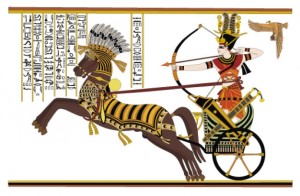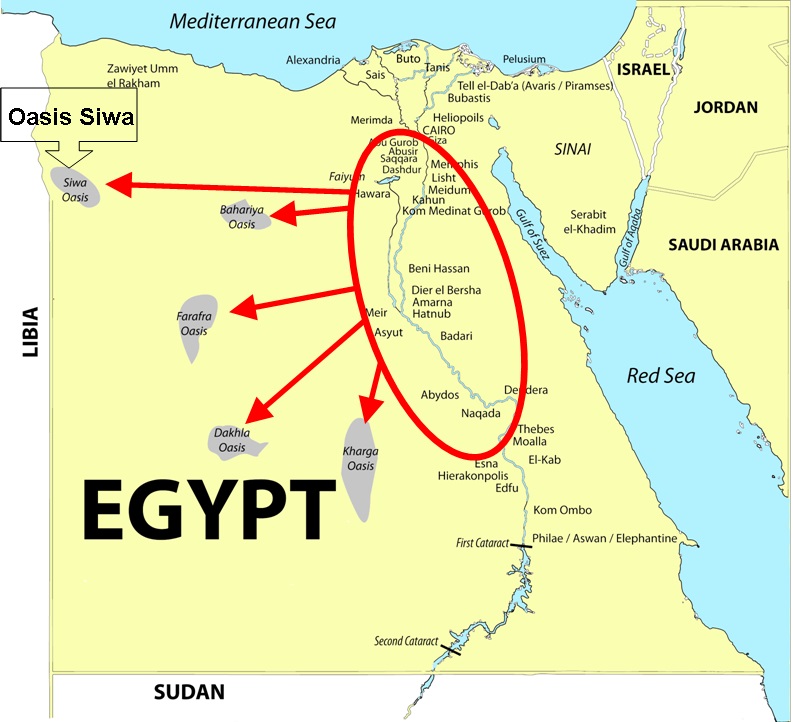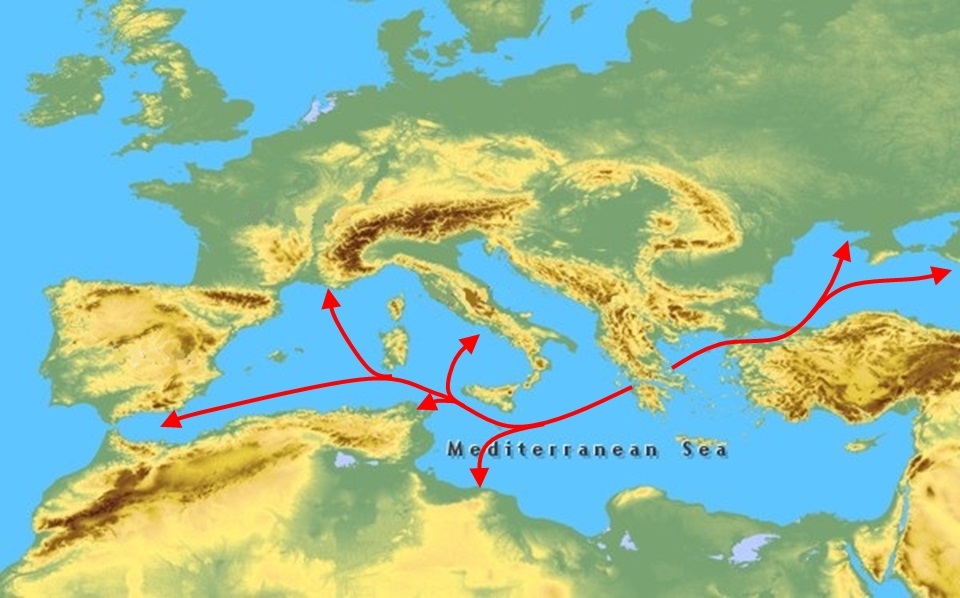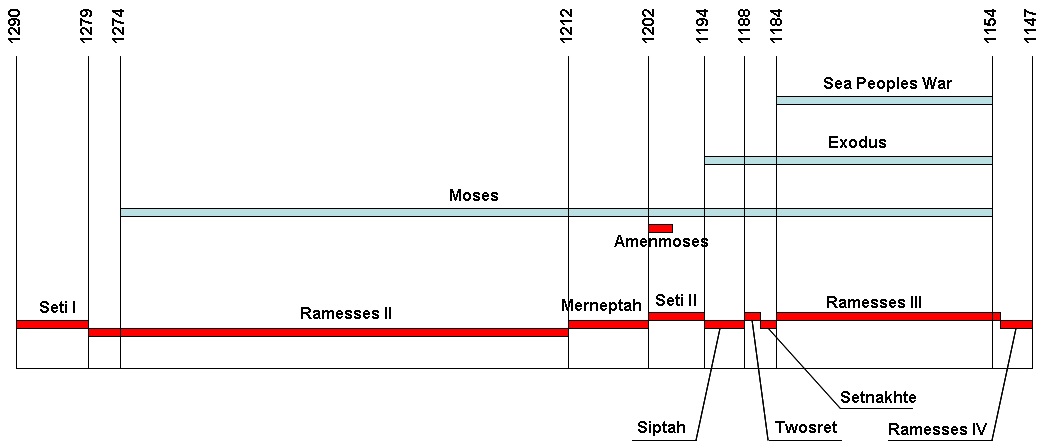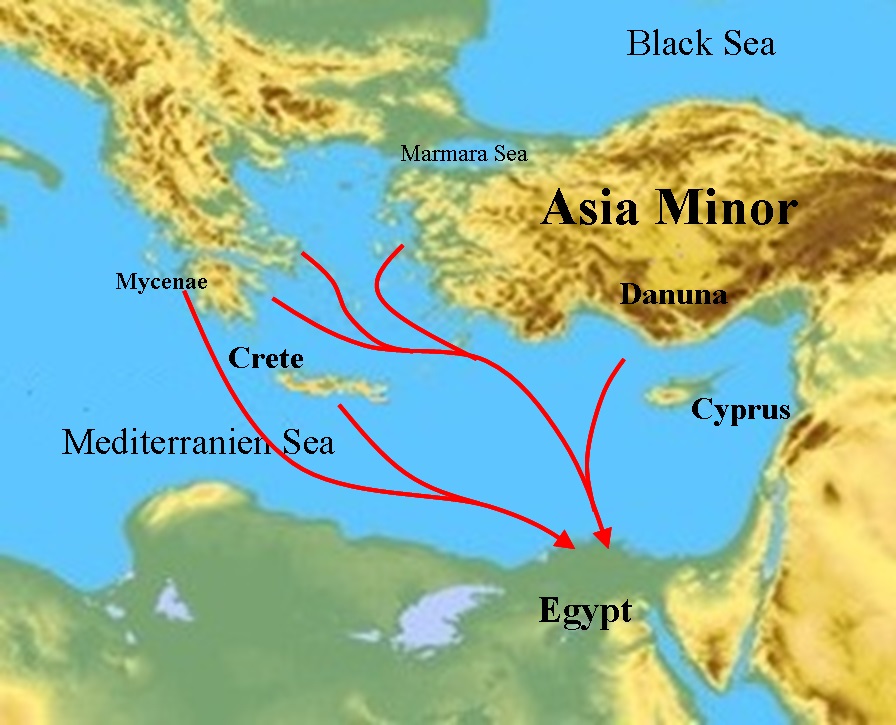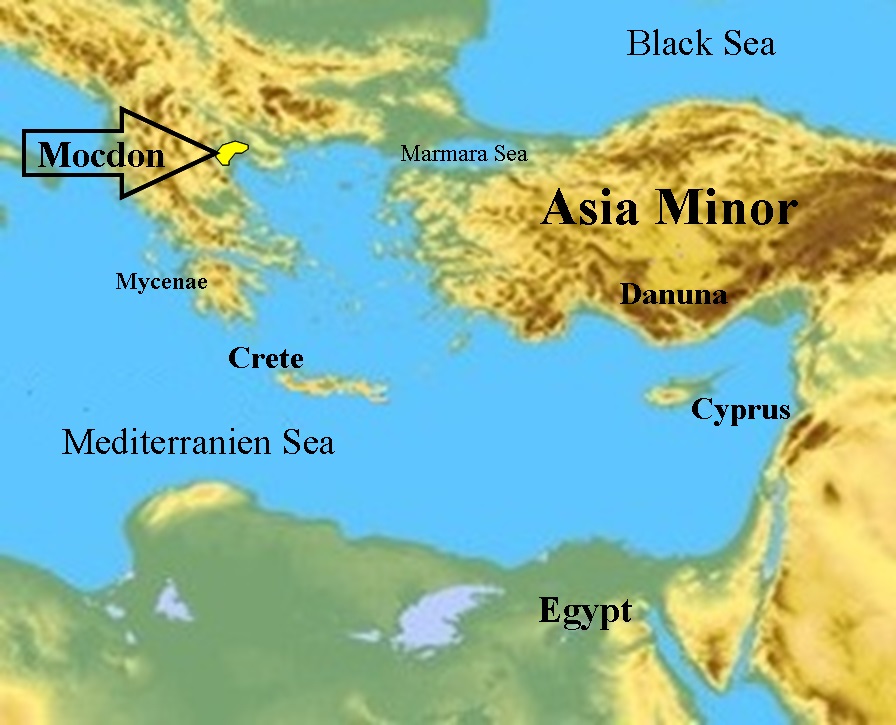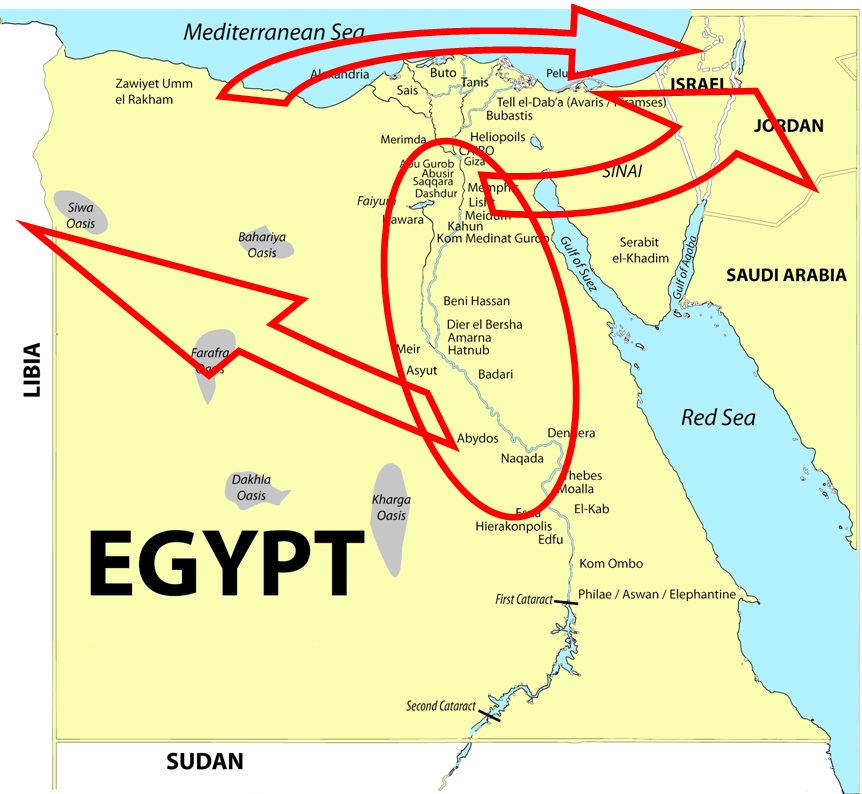Having departed from Egypt, the Jews for 40 years were in Sinai at a distance of a hundred miles from the Pharaoh’s Palace. Why did Pharaoh not pursue them and try to bring them back to Egypt? What he has been busy with?
You will find answers in this article.
-
EGYPT IN THE 18th – 17th CENTURIES BC
The beginning of the 2nd millennium BC. The main occupation of the Egypt’s population, concentrated along the Nile River, was agriculture.
In the middle of the 18th century BC Lower Egypt was conquered by the Hyksos (Hycsos, Ὑκσώς, Ὑξώς, هكسوس, חיקסוס, היקסוס,). The word “Hyksos” came to us from Ancient Greece in the 6th century BC. About how they called themselves, read in the article “Who are you, Pharaoh?”).
With the advent of the Hyksos, the Iron Age came to Egypt. New military equipment appeared: a relatively complex angular bow, different types of swords and daggers, a new kind of shield, chain armor and a metal helmet. The most important innovation is a two-wheeled chariot drawn by horses.
Figure 01
Having arrived in Egypt in chariots with iron weapons in their hands and in iron armor, the Hyksos seized power without a battle. The period of 1750 – 1550 BC is the reign of the 15th and the 16th dynasties of Pharaohs originating from the Hyksos.
-
THE ADVENT OF JEWS TO EGYPT
In the middle of the 17th century BC the Jews are the forefather Jacob who was the son of Isaac, the grandson of Abraham and his 12 sons, as well as their women and children. Joseph (the eldest son of Jacob from Rachel), sold by his brothers, arrives in Egypt and comes into contact with Pharaoh.
Pharaoh (originally from the Hyksos!) takes a liking and trust for Joseph, much more than for the Egyptians around him, and therefore appoints him responsible for the economy of the whole state (see the article “Who are you, Pharaoh?”). Taking advantage of seven years of drought and impoverishment of the population, Joseph buys up Egyptian lands on the cheap in favor of Pharaoh, which causes even greater favor of Pharaoh.
In 1624 BC (see the article “Chronology of the Fathers”), the forefather Jacob’s family, driven by hunger, move from the land of Canaan to Egypt and, using the protection of Joseph, settle in the land of Goshen – the most fertile and livestock-friendly district.
-
THE LAND OF GOSHEN – WHERE IT IS?
The following facts point to the position of the land of Goshen:
תורה ספר בראשית
מה,י וְיָשַׁבְתָּ בְאֶרֶץ-גֹּשֶׁן, וְהָיִיתָ קָרוֹב אֵלַי—אַתָּה, וּבָנֶיךָ וּבְנֵי בָנֶיךָ; וְצֹאנְךָ וּבְקָרְךָ, וְכָל-אֲשֶׁר-לָךְ
Torah, Book 1 Genesis, Chapter 45
10 And thou shalt dwell in the land of Goshen, and thou shalt be near unto me, thou, and thy children, and thy children’s children, and thy flocks, and thy herds, and all that thou hast;
* this area is up the Nile from Pharaoh’s Palace – that is why the basket with the newborn Moses sailed along the river to the Palace, at the feet of Pharaoh’s daughter.
* this place is located to the west of the Red Sea – therefore the Jews, leaving from slavery to the east (to the Sinai desert), had to cross the Red Sea.
* the Torah claims that this area was suitable for raising flocks and herds.
תורה ספר בראשית
מז,ה וַיֹּאמֶר פַּרְעֹה, אֶל-יוֹסֵף לֵאמֹר: אָבִיךָ וְאַחֶיךָ, בָּאוּ אֵלֶיך. מז,ו אֶרֶץ מִצְרַיִם, לְפָנֶיךָ הִוא—בְּמֵיטַב הָאָרֶץ, הוֹשֵׁב אֶת-אָבִיךָ וְאֶת-אַחֶיךָ: יֵשְׁבוּ, בְּאֶרֶץ גֹּשֶׁן
Torah, Book 1 Genesis, Chapter 47
5 And Pharaoh spoke unto Joseph, saying: ‘Thy father and thy brethren are come unto thee; 6 the land of Egypt is before thee; in the best of the land make thy father and thy brethren to dwell; in the land of Goshen let them dwell … ‘
Conclusion: the land of Goshen was located near the Nile Delta to the south of it, i.e. upstream.
Figure 02
-
THE LAND OF GOSHEN IS FAIYUM
The region, referred to above, subsequently received a name Faiyum.
Faiyum is an oasis separated from the Nile valley by a chain of hills. This tectonic basin is located 44 m below sea level. The area of the oasis is about 1270 km². In the Faiyum Oasis there is the oldest hydrotechnical structure – Lake Qarun. Ancient authors considered it one of the wonders of the world. There are its descriptions by Herodotus, Diodorus, Strabo, Ptolemy and Pliny. Nowadays Lake Qarun has an area of about 200 square km. In ancient times it was much larger and was perceived by the ancient Jews as the sea, hence the name of the oasis of Faiyum derived from the word (Hebrew) בים [ba-yam] = (English) ‘at the sea’. The locals still call it the sea today – (Arabic) بحيرة قارون = the sea of Qarun.
The ancient Jews called the sea of Qarun (Hebrew) מורד [morad] = (English) ‘the lowland, the bottom, the descent’ – that is how its ancient Greek name Mоίριδος [moyridos] appeared. Therefore, in ancient literature this water reservoir is called Lake Moeridos or the Moerdois Sea. Eventually, the name of this reservoir in the Greek language has changed and then passed into European languages:
Μοίριδος [moyridos] → Μοῖρις [moyris] → (English) Moeris [moyris]
The canal that fills Lake Qarun with the waters of the Nile is called (Arabic) بحر يوسف [bahr yusuf] = (English) ‘the sea of Joseph’, in honor of Joseph, son of the forefather Jacob, who constructed it (see the article “About the Nature of Laws and the Laws of Nature”). It is to this channel that Qarun owes its birth and existence.
Figure 03
Over time, the Jews brought under cultivation the Nile Valley upstream, and settled oases suitable for cattle breeding, west of the Middle Nile.
Figure 04
It was in these places that the first inscriptions in the phonetic alphabet in the history of mankind were found which was the prototype of the modern European alphabets (see the article “Why does Europe Write Left-to-Right?”). Archaeologists attribute these inscriptions to the 16th century BC, i.e., namely, to the period of the settlement of Jews in these places.
In the Siwa Oasis, located at a distance of about 500 km west of the Faiyum Oasis, still live the descendants of the Jews, who some scholars consider to be one of the branches of the Berber people. There was an ancient building in this oasis, built in the middle of the 16th century BC, i.e. approximately 100 years after the arrival of the forefather Jacob’s family in Egypt. It was intended for cult purposes and played an important role in the fate of Alexander the Great – this is discussed in the article “Alexander the Great – him too?”. It is called the Temple of Amon. Amon was believed to be the god of the ancient Egyptians. In fact, the notion of Amon originated from the word (Hebrew) אמונה [emuna] = (English) ‘faith’. This building – “house of faith” – can be considered the oldest synagogue. It was exploded in 1895 by the Egyptian authorities. Today there is another building in the Siwa Oasis, built in the 5th century BC and also called the Temple of Amon. This is a forgery, the purpose of which is to erase the true exploded temple from the memory of mankind.
-
THE NUMBER OF JEWS IN EGYPT
The duration of the Jewish presence in Egypt is estimated by different scientists in different ways: from 210 to 430 years. The Torah clearly indicates a period of 430 years:
תורה, ספר שמות
יב, מ וּמוֹשַׁב בְּנֵי יִשְׂרָאֵל, אֲשֶׁר יָשְׁבוּ בְּמִצְרָיִם—שְׁלֹשִׁים שָׁנָה, וְאַרְבַּע מֵאוֹת שָׁנָה
Torah, Book 2 Exodus, Chapter 12
40 Now the time that the children of Israel dwelt in Egypt was four hundred and thirty years.
The number of male Jews fit for combat aged over 20 years a year after the beginning of the Exodus was 603,550 people, except for the Levites (Torah, Book 4 Numbers, Chapter 1, verses 17 – 47). The total number of Jews in Egypt before the beginning of the Exodus was about 3.9 million people (for further information please refer to the article “Numbers”).
A simple calculation shows:
* in order to reach such a number, about 4 children on the average survived in Jewish families, which is quite realistic.
* eighty years before the Exodus the total number of Jews was about 500,000 people – this number will prove useful to us further.
-
EMIGRATION IN THE AEGEAN SEA AREA
The indigenous population of Egypt was not favorably disposed towards the Jewish people.
תורה, בראשית
מג,לא וַיִּרְחַץ פָּנָיו, וַיֵּצֵא; וַיִּתְאַפַּק–וַיֹּאמֶר, שִׂימוּ לָחֶם. מג,לב וַיָּשִׂימוּ לוֹ לְבַדּוֹ, וְלָהֶם לְבַדָּם; וְלַמִּצְרִים הָאֹכְלִים אִתּוֹ, לְבַדָּם–כִּי לֹא יוּכְלוּן הַמִּצְרִים לֶאֱכֹל אֶת-הָעִבְרִים לֶחֶם, כִּי-תוֹעֵבָה הִוא לְמִצְרָיִם
Torah, Book 1 Genesis, Chapter 43
31 And he washed his face, and came out; and he refrained himself, and said: ‘Set on bread.’ 32 And they set on for him by himself, and for them by themselves, and for the Egyptians, that did eat with him, by themselves; because the Egyptians might not eat bread of the Hebrews; for that is an abomination unto Egypt.
Negative attitudes increased after the overthrow of the dynasty of Hyksos Pharaohs in 1550 BC by Pharaoh Ahmose I. The Jewish population, suspected of sympathizing with the Hyksos, did not enjoy the authorities’ favor. This situation forced the most initiative of the Jews to make the decision to emigrate.
In the late 17 century BC the Santorini volcano eruption destroyed the population of the Aegean Sea area – the Minoan civilization ceased to exist. The first Jewish refugees from Egypt appeared there in the 16th century BC.
Figure 05
These immigrants were shepherds. It is not surprising that one of the settlements founded by them was named (Hebrew) מִקְנֶה [mikne] = (English) ‘herd’. Later this settlement turned into a city (Greek) Μυκήνη [mikini] = (English) Mycenae.
In the city of Mycenae, a large community of Jews from the tribe of Dan ((Hebrew) דן [dan]) settled, which laid the foundation for the civilization that we call the Mycenaean civilization. A man from the Dan’s tribe is called in Hebrew דנאי [danai] – so in different languages the words Danaus, Danai, Danunite, Δαναοί, danaan, denyen, danunäer appeared.
The Denyen became navigators. They maintained close business and military cooperation with the Jews from other tribes scattered on the shores and islands of the Mediterranean. Addressing each other, the Jews used the word (Hebrew) אחי [ahi] = (English) ‘my brother’, as many Israelis do nowadays. Therefore, in the literature, the Jews of the Diaspora of those times were called achaeans, aχαιοί, achaei, achivi.
The Achaeans, who settled in the Mediterranean region in the 16th and 13th centuries BC, founded many settlements and became the basis of that friendly local population, which, 500 years later, at the end of the 8th century BC absorbed a huge amount of Israelis fleeing from the invasion of the Assyrian king Tiglath-Pileser III (for further information please refer to the article “Full Circle”).
In the course of military and commercial operations, the Denyen greatly expanded the boundaries of their habitat:
- northward to the area of the future Macedonia;
- to the north-east in the area of the Marble and Black seas. The siege and capture of Troy were part of this action, described afterwards about 700 years in the poem “The Odyssey” by Homer;
- eastward along the coast of Asia Minor. To the north of Cyprus, the Denyen founded the state of Danuna. The large city of Adana = (Aramaic) אדנא [adana] = (Hebrew) הדן [hadan] = (English) the Dan) still exists in Turkey.
Figure 06
The Denyen founded many settlements on the shores of the Black Sea, where they carried on a vigorous trade with the Scythians (the legend of the Golden Fleece). These relations laid the foundation for the friendship that reunited these peoples at the end of the 8th century BC in the period of the escape of the Denyen from the Assyrian king Tiglath-Pileser III (for further information please refer to the article “Full Circle”).
-
EUROPE IN THE 15th – 13th CENTURIES BC
The population of Europe in the middle of the 2nd millennium BC was extremely scarce and it was in primitive state. It was engaged exclusively in survival – gathering and primitive hunting. The nomadic way of life prevented the development of technologies related to settled life, such as agriculture, construction technology, metal processing and so on.
The appearance of Jewish refugees from Egypt on the shores of the Mediterranean led to a civilizational leap. Aborigines flocked to the settlements – sources of food, and settling nearby, they learned from the settlers. Many settlements became the basis for future cities. For instance, one of them, named (Hebrew) משלה [mashala] = (English) ‘dominant’ turned many years later into the city of Marseille in France.
Figure 07
Settlements founded by the Achaeans and the Denyen on the Apennine peninsula are now called the Villanova culture. After 500 years, they became strongholds at the founding of the city of Rome and the cities of the Etruscans (for further information please refer to the article “The Golden Triangle”).
By the end of the 13th century BC the union of the Denyen and the Achaeans turned into a powerful military trade monopoly possessing:
– great experience in developing territories and establishing settlements;
– detailed information on navigation in the Mediterranean and Black Seas;
– a well-trained and organized army and navy.
Someday all this disappeared!!!
Where and why?
-
DECISIVE DECREE
In 1550 BC the 16th dynasty of Hyksos Pharaohs was overthrown. The 17th dynasty, which originated from ethnic Egyptians, ascended the throne.
A while later in 1279 BC the ruler of Egypt became Ramesses II the Great. During his reign, events took place that changed the fate of the Jewish people.
In 1274 BC there was the Battle of Kadesh between the armies of Egypt and the Hittite Empire (please further refer to the article “And They Made Their Lives Bitter”). Consequently, Ramesses II was forced to return to Egypt “getting cold feet”.
In this battle the Denyen and Achaeans’ troops, equipped with chariots and iron weapons, took the side of the Hittites. In the Pharaoh’s opinion, they caused his defeat.
At that time the Jewish population of Egypt reached half a million people (see above). Ramesses II understood that in the case of a large-scale war, the Jews of Egypt would act on the side of their relatives, the Denyen and the Achaeans.
Gripped by fear, he issued a decree that was unprecedented in its cruelty:
תורה, ספר שמות
א,ט וַיֹּאמֶר, אֶל-עַמּוֹ: הִנֵּה, עַם בְּנֵי יִשְׂרָאֵל–רַב וְעָצוּם, מִמֶּנּוּ. א,י הָבָה נִתְחַכְּמָה, לוֹ: פֶּן-יִרְבֶּה, וְהָיָה כִּי-תִקְרֶאנָה מִלְחָמָה וְנוֹסַף גַּם-הוּא עַל-שֹׂנְאֵינוּ, וְנִלְחַם-בָּנוּ
א,טז וַיֹּאמֶר, בְּיַלֶּדְכֶן אֶת-הָעִבְרִיּוֹת, וּרְאִיתֶן, עַל-הָאָבְנָיִם: אִם-בֵּן הוּא וַהֲמִתֶּן אֹתוֹ, וְאִם-בַּת הִוא וָחָיָה.
Tora, Book 2 Exodus, Chapter 1
9 And he said unto his people: ‘Behold, the people of the children of Israel are too many and too mighty for us; 10 come, let us deal wisely with them, lest they multiply, and it come to pass, that, when there befalleth us any war, they also join themselves unto our enemies, and fight against us, …
16 and he said: ‘When ye do the office of a midwife to the Hebrew women, ye shall look upon the birthstool: if it be a son, then ye shall kill him; but if it be a daughter, then she shall live.
In the history of the Jews a period began, identified with Egyptian slavery.
-
TWO EGYPTS
During the reign of the pharaohs Ramesses II and his son Merneptah, the central authority in Egypt was strong. With the death of Merneptah in 1202 BC, Egypt plunged into the turmoil of dual power. Upper Egypt was under the rule of a man named Amenmesse, Lower Egypt – under the authority of Pharaoh Seti II.
Egypt was called Misr in the languages of that time – Assyrian, Akkadian, Aramaic. This name migrated from Aramaic to Arabic مِصرَ [misr] and survived till the present day.
And only in Hebrew the name of this country מצרים [mitsraim] takes the dual form, for instance:
- (Hebrew) אוזן [ozen] = ear → (Hebrew) אוזנים [oznaim] = two ears
- (Hebrew) כנף [kanaf] = wing → (Hebrew) כנפים [knafim] = two wings
- (Hebrew) מצר [mitsr] = Egypt → (Hebrew) מצרים [mitsraim] = two Egypts
The events preceding the Exodus from Egypt occurred at a time when Egypt was divided into two authority zones: Upper Egypt and Lower Egypt (see below). This fact was preserved in the collective memory of the Jews as the dual name of Egypt.
-
WHO ARE YOU, AMENMESSE?
As stated above, in Upper Egypt, a man named Amenmes ruled.
German Egyptologists M. Georg and R. Krauss note that there are a variety of parallels between the history of the Amenmesse’s government, recreated in accordance of archaeological researches, and the biblical story of Moses in Egypt:
- Rolf Krauss, Untersuchungen zu Konig Amenmesse: Nachtrage, SAK 24 (1997), pp.161-184
- Georg, M (2000), “Mose – Name und Namenstraeger. Versuch einer historischen Annaeherung” in “Mose. Aegypten und das Alte Testament”, edited by E. Otto, Verlag Katholisches Bibelwerk, Stittgart
- Rolf Krauss, “Das Ratsel Moses-Auf den Spuren einer Erfindung biblischen”, Ullstein Verlag, Munchen 2001
The reader is recommended to pay attention to the following facts:
- The forefather Jacob settled in the land of Goshen, and then his descendants settled upstream of the Nile. Upper Egypt is the area of the Jewish resettlement (see above).
- During the period of dual power in Egypt, there appeared The Tale of Two Brothers (the Papyrus D’Orbiney), containing information about the power-sharing in the Upper and Lower Egypt between the brothers. According to the Torah, Moses was adopted by the daughter of Pharaoh Ramesses II (see the quote below), hence he was the half-brother of Pharaoh Seti II, Ramses II’s grandson.
- European languages brought to us the following options for sounding of the name: Amenmes, Amenmesse, Amenmesses, Amenmoses. The Arabic language has preserved for us this name consisting of two words:
أمن مسه [aman moshe] = master Moshe
- Assuming that Amenmesse is Moses, it is not surprising that he acquired a significant (royal) influence precisely in Upper Egypt inhabited by Jews.
A cautious conclusion: the facts known to modern science suggest that Amenmesse is Moses.
-
WHO ARE YOU, MOSES?
From the Torah we know that the real name of Moses is Moshe:
תורה, ספר שמות
ב,י וַיִּגְדַּל הַיֶּלֶד, וַתְּבִאֵהוּ לְבַת-פַּרְעֹה, וַיְהִי-לָהּ, לְבֵן; וַתִּקְרָא שְׁמוֹ, מֹשֶׁה, וַתֹּאמֶר, כִּי מִן-הַמַּיִם מְשִׁיתִהוּ
Tora, Book 2 Exodus, Chapter 2
10 And the child grew, and she brought him unto Pharaoh’s daughter, and he became her son. And she called his name Moses, and said: ‘Because I drew him out of the water.’
From the passage we see that the word (Hebrew) משה [moshe] came from the word (Hebrew) מְשִׁיתִהוּ [moshitihu] = I drew him out.
How did the name Moses appear?
In the history of Egypt there were 5 pharaohs with the similar names, which nowadays are pronounced like that: Kamose, Ahmose, Thutmose, Rameses, Amenmeses.
Let us give the correct sound and meaning of these names:
- Kamose → Ка moses → born by the god Ka
- Ahmose → Ah moses → born by the moon
- Thutmose → Thut moses → born by the god Thoth
- Ramesses → Ra moses → born by the god Ra
- Amenmesse → Amen moses → born by the Lord (this name is an evidence to faith in the One God)
The second part of the last-mentioned name, about 700 years later, migrated to the emerging Greek language in the form of (Greek) Mωϋσῆς, and from there, 2000 years later, to other languages:
(Greek) Μωυσής [mousis] → (English) Moses [mozes]
-
THE TIME HAS COME
Approximately in 1202 BC, immediately after the death of the Merneptah, Moses decides to take the Jews from Egypt. However, the main concentration center of the Jewish population was in the land of Goshen, i.e. in the Faiyum area, located in the immediate vicinity of the palace of Pharaoh Seti II. To begin the Exodus, Moshe had to obtain the Pharaoh’s consent. There began a chain of arrangements described in the Torah in the form of a story of 10 executions. These negotiations lasted for several years and led to tension within the country. At different stages, they were probably accompanied by military actions. It is known that the capital of Upper Egypt, the city of Thebes, was captured by Pharaoh Seti II somewhere in 1198 BC.
Moses failed to persuade Seti II – he died in 1194 BC. After him, Pharaoh Siptah, a boy at the age of 10, ascended to the throne of Egypt.
Taking advantage of the lack of authority, Moses decided to seize the moment and the Exodus began. In 1194 BC (please refer to the article “Chronology of the Fathers”) the first group of Jews left Egypt, the details of the Exodus of which are described in the Torah – crossing the Red Sea, etc. The others followed it.
In the next 10 years in Egypt, three Pharaohs succeeded each other. They were busy holding power and, therefore, were not a threat to the Jews leaving Egypt for Sinai.
Figure 08
In 1184 BC Pharaoh Raameses III ascended to the throne of Egypt. The central power has grown stronger. Egypt’s area of interests again included the territories adjoining to it. In this period and until 1154 BC Jews settled in the Sinai desert that gave the opportunity to arrive for their congeners still remaining in Egypt. The question arises: why for 30 years Pharaoh Ramesses III did not try to return the slaves who were in Sinai at a distance of a hundred or two hundred miles from his palace?
The answer is: Pharaoh Ramesses III was busy with more important matters!
What are they?
-
OPENING OF THE 2ND FRONT
Around 1184 BC the Jewish Diaspora (the Denyen and the Achaeans) performed coastal landing on the northern coast of Egypt with the aim of diverting the armed forces of the Pharaoh and allowing the Jews of Egypt to continue the Exodus.
Figure 09
In historical literature this action is called the “war of the Sea Peoples”. It lasted about 30 years (until the end of the Exodus).
Pharaoh Ramesses IV unreasonably argues (please refer to the Great Harris Papyrus) that his father Pharaoh Ramesses III defeated the Peoples of the Sea. This is not true!
The war of the Peoples of the Sea ceased in 1154 BC just as suddenly as it began. But the Denyen and Achaeans did not return to the Aegean Sea basin. It is well-known in a science that the Mycenaean civilization ceased to exist almost immediately – the so-called “Dark Ages” began on the territory of prehistoric Greece. No traces of people’s activity have been found in this area since the middle of the 12th century BC and up to the last third of the 8th century BC, that is, the writing has been lost for the period about 420 years, there are no traces of construction and land cultivation. According to the archaeologists’ terminology, the cultural layer corresponding to this period simply does not exist.
Where did the population of Greece disappear?
With the end of the Exodus from Egypt, the Jews left the Sinai desert and settled in the Promised Land – in Canaan. Specific measures for distracting military operations on the shores of Egypt were no longer needed – the Denyen and Achaeans ceased the “war of the Sea Peoples” and headed east to reunite with the rest of the people.
Figure10
-
THE PROMISED LAND!
Having waited for the Exodus of most Jews from Egypt, in 1154 BC Moses decides to bring the people into Canaan. Joshua the son of Nun settles 12 tribes, dividing the country as follows:
Figure 11
The Denyen and Achaeans ceased fighting on the shores of Egypt at the same time and headed for Canaan’s shores.
The Achaeans landed west of the tribe of Judah’s land plot ((Hebrew) יהודה [ehuda]) and settled in five Philistine cities: Gaza, Ashdod, Ashkelon, Gath, Ekron:
נביאים, ספר יהושוע
יג,ג מִן-הַשִּׁיחוֹר אֲשֶׁר עַל-פְּנֵי מִצְרַיִם, וְעַד גְּבוּל עֶקְרוֹן צָפוֹנָה — לַכְּנַעֲנִי, תֵּחָשֵׁב; חֲמֵשֶׁת סַרְנֵי פְלִשְׁתִּים: הָעַזָּתִי וְהָאַשְׁדּוֹדִי הָאֶשְׁקְלוֹנִי הַגִּתִּי וְהָעֶקְרוֹנִי, וְהָעַוִּים
Bible (King James)/Joshua, chapter 13
3 From Sihor, which is before Egypt, even unto the borders of Ekron northward, which is counted to the Canaanite: five lords of the philistines: the Gazathites, and the Ashdothites, the Eshkalonites, the Gittites, and the Ekronites; also the Avites:
Some of these cities still exist (please refer to the article “Where is Hercules Buried?”).
The Denyen landed on the beach in the area of the modern city of Tel Aviv in order to reunite with its allied tribe of Dan. Nowadays this area is called Gush Dan.
Figure12
A curious reader can refer to the article “Full Circle” to get to know what happened afterwards.
-
ON MACEDONIA
With the end of the war of the Sea Peoples, the islands and the coast of the Aegean Sea were practically deserted – the so-called “Dark Ages” of Greece began. However, in this territory there still remains a small Jewish population, which concentrated on the north-western tip of the Aegean Sea. This region is called in Hebrew מוקדון [mokdon] = (English) ‘concentration, focus’ till the present day. This word has passed to other languages in the form of Macedonia, Μακεδονία, Македония.
Figure13
The Jews of Mocdon performed their important role in 420 years – in 730 BC they sheltered the Denyen who had fled from the persecution of Tiglath-Pileser III, king of Assyria (this is discussed in the article “Full Circle”).
-
ОN THE BERBERS
After the Exodus of most of the Jews to the east in Sinai, some of them remained in Egypt. A part of them, mostly residents of the western oases, eventually migrated to the west and became the basis of the Berber people who settled in the territories of northwestern Africa. About 1,000 years later, their ranks were replenished by the Jews who had escaped from Carthage destroyed by the Romans (this is described in the article “The Golden Triangle”).
The Berber alphabet called TIFINAGH is based on the ancient Hebrew alphabet.
The word “Berber” came to us from Greek. The Berbers call themselves “Amahag” or “Amazigh”.
The word “Amahag” originated from (Hebrew) עם החג [am ha-hag] = the people of the feast.
The word “Amazigh” originated from (Hebrew) עם הזיג [am ha-zig] = people behind the partition.
-
THE SPARTANS – NOT THE SPARTIATES
The cities of prehistoric Greece were depopulated before 730 BC. Much later, around the 5th century BC, there appeared and was written a legend about the creation by Spartiates (not to be confused with the Spartans!) of the military state in Sparta during the “Dark Ages” with the extremely cruel laws established by Lycurgus (for example, killing of unhealthy and ugly babies). The Spartiates left us NO material evidences of their existence and there is no evidence of their contacts with the Jews of Mocdon at that time, therefore the authenticity of this story is doubtful.
-
SUMMARY
- In 1194-1154 BC about 3.9 million Jews left Egypt and settled in the Promised Land called Canaan.
- During the same period, the Jews of Diaspora (the Denyen and Achaeans nicknamed by the Egyptians “the Sea Peoples”) left the territory of prehistoric Greece, as well as many settlements on the islands and on the shores of the Mediterranean, and joined the rest of the people in Canaan.
- A certain number of Jews moved to the west and set the basis of the Berbers.
- The Jews remaining in Egypt concentrated in the Faiyum area and subsequently sheltered the Jews who were fleeing from various cataclysms that overtook them in Canaan, such as the invasion of Tiglath Pileser III, king of Assyria, in the late 8th century BC (read a little about this in the article “Ev and Kiev – History Repeats Itself”), as the invasion of the Babylonian king Nebuchadnezzar II in the early 6th century BC, or the invasion of the hellenized Assyrians in the 3d – 2nd centuries BC, etc.
Figure14
There are other articles on this site. A list of them here

